By: Diana Garofolo
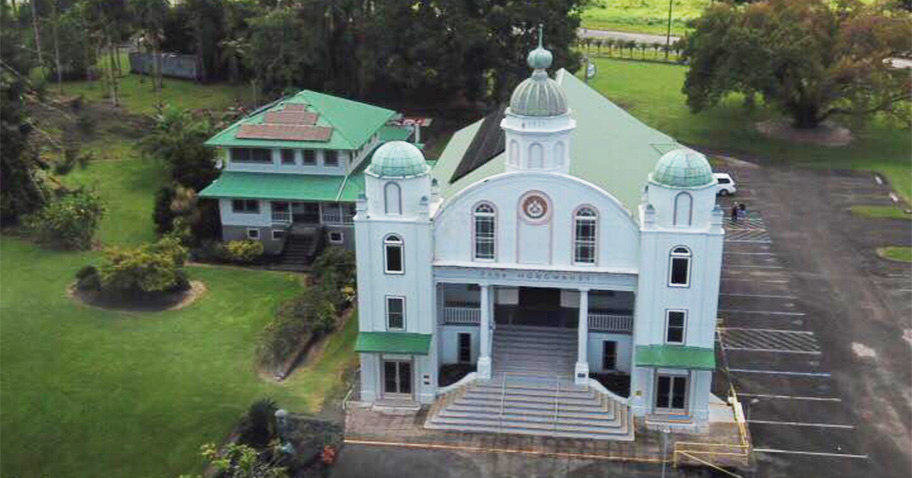
Introduction
Puna Hongwanji (formally known as Olaa Hongwanji ) is a Pure Land Shin Buddhist temple located on Hawaii’s beautiful Big Island. It was founded in 1902 on the land which was subleased from Olaa Sugar Company. Puna Hongwanji provided spiritual support and guidance for first generation Japanese immigrants, offering things such as Japanese school, activities, and Buddhist services. Behind the temple and columbarium stands a bodhi tree, which was propogated from a cutting in Thailand, whose history dates to a cutting from the bodhi tree under which the historical Buddha, Shakyamuni attained enlightenment.
History of the Temple

Founded in 1902 at the request of Japanese immigrant workers, a minister was sent to Olaa (also known as Keauu), located in the District of Puna, to serve the spiritual needs of the community through Jodo Shinshu teachings. The land was subleased from Olaa Sugar Company, and a wooden traditional Japanese temple was built on the site where the Puna Hongwanji Mission now stands.
During WWII, all Buddhist ministers were interned in relocation camps, and temple facilities, including school buildings, were taken over by the military. Due to the efforts of President Tsugio Tanaka, the temple was reopened and was allowed to conduct services on Sundays and New Year. After the end of the war, temple and activities were reactivated.
In 1934, the Olaa Hongwanji established a Board of Directors to manage the affairs of the temple. The board decided to construct a larger temple, two parsonages, and a kitchen because the congregation had outgrown the existing facilities. Construction began in early 1937 and in May 1938, the project was complete.
Herbert Shipman, President of W.H. Shipman Company, who was the landowner of Olaa Hongwanji, suggested that the mission change its name to Puna Hongwanji, since it served the entire Puna district. In 1957, the temple’s name changed to Puna Hongwanji Mission.
In honor of the temple’s 60th Anniversary and the Founder Master Shinran’s 700th memorial celebration projects, a new kitchen, dining room complex and a new columbarium were built in 1963 by temple members. Various projects such as construction of a parking lot, refinishing pews, covering the temple and office floors with vinyl tiles and more were planned and completed. The temple grounds were donated by the Shipman family. A deed was officially presented by Roy Blackshear, on behalf of the Shipman family, to Puna Hongwanji Mission on October 17, 1976. Experiencing the transfer of ministers, and the closing of Puna Sugar Company, Puna Hongwanji continued to carry on the mission and completed many projects
Jodo Shinshu

The Puna Hongwanji community practices Shin Buddhism, which is based on the life and writings of Master Shinran (1173- 1263), who traced the commentaries of seven Buddhist masters back to their source of inspiration. Dharma is the teachings of Buddhism, and its essence is the enlightenment of the universal truth. In the Hongwanji tradition, Amida Buddha, the Buddha of Compassion and Wisdom, made vows to embrace all people as they are, emancipate all beings from sufferings, and bring utmost bliss and peace to every single person. With Great Compassion and Wisdom, Amida Buddha embraces us as we are and includes all without discrimination, allowing us to live our lives to the fullest with humility and gratitude.
Through the Vow of Amida Buddha, we as human beings are able to see our true natures of human ego, self-centeredness, Greed, Anger, and Bombuness (foolishness). Not knowing our true selves, we try to live lives of peace and gratitude each day. We will help and work together with mutual respect and understanding for our families, friends, and larger communities in a world guided by Amida Buddha. In the embrace of Amida Buddha, we will receive everlasting happiness during uncertainty and worry.
Scriptures and Teachings of Jodo Shinshu
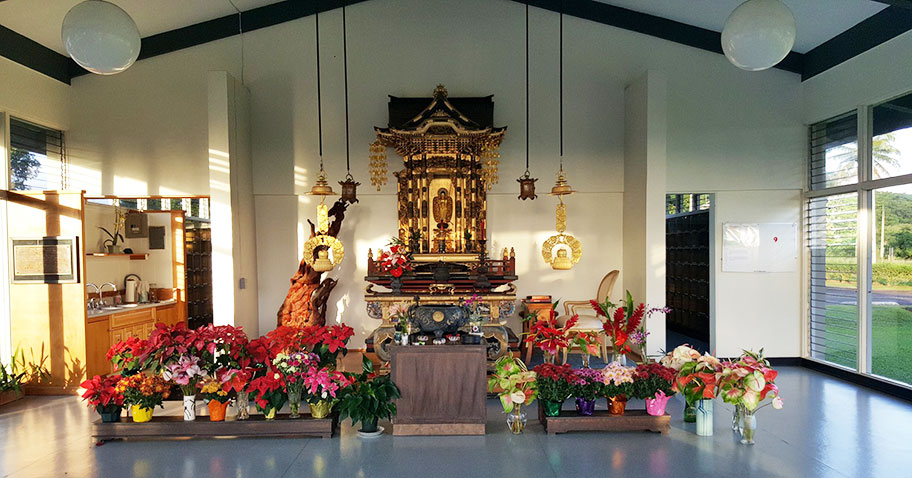
Puna Hongwanji follows three categories of scripture. First is The Sutras: The Three Pure Land Sutras Delivered by Shakyamuni Buddha. Second is Shinran Shonin’s writings. Third is Rennyo Shonin’s Gobunshō Letters. The goal is to attain the “entrusting heart,” awakening to the compassion of Amida Tathagata (Buddha); through the working of the Primal Vow, Buddhists will walk the path of life reciting Amida’s Name (Nembutsu). At the end of life, they will be born in the Pure Land and attain Buddhahood, returning at once to this world to guide people to awakening. Lead by the teachings of Shinran, they listen to the compassionate calling of Amida Tathagata and recite the Nembutsu. The Hongwanji school is a community of people joined together, revering the teachings of Shinran and saying the Nembutsu. They seek to share with others the wisdom and compassion of Amida Tathagata. By doing so, they work toward the realization of a society in which everyone can live a life of spiritual fulfillment.
Buddhism Classes and Social Issues

Puna Hongwanji offers Buddhism classes with current Reverand Tomioka every Sunday. The purpose of these classes is to learn the teachings of Buddhism and apply them to everyday lives, workplaces, homes, and schools. On their website, Puna Hongwanji uploads the class documents. They also offer weekly services on Sunday, either online or in-person, to make it easy for anyone to attend. According to Puna Hongwanji, Buddhism and Jodo Shinshu are relevant to modern social issues. Teachings can provide guidance for challenges as a society, as communities, and as individuals; therefore, social issue can provide a compelling context in which to deepen our understanding of the Dharma. This is applicable to homelessness, immigration, and gun violence.
Volunteering at Puna Hongwanji
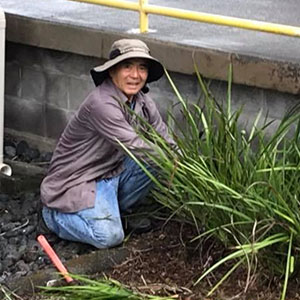
At Puna Hongwanji, there are opportunities to participate in the various temple activities, meet old friends, and make new ones. Puna Hongwanji believes in serving the community as an expression of the Buddhist value Dana, or selfless giving without expecting anything in return. Members are those who choose to support the temple with annual membership dues. The suggested membership dues are $240 per year per family.
Anpan (a bun with red beans inside) and milk bread is made in alternate months from January to October, on every 4th Wednesday. A bag containing two anpan is available for purchase. The funds raised are used for kitchen repairs, needs, and improvements. Puna Project Dana is a volunteer, nondenominational organization, which is an approved activity of Puna Hongwanji. The purpose of Project Dana is to “provide a variety of faith-based volunteer services to the frail elderly, the disabled and caregivers who are in need of social support in order to maintain a reasonable quality of life.”
Funding
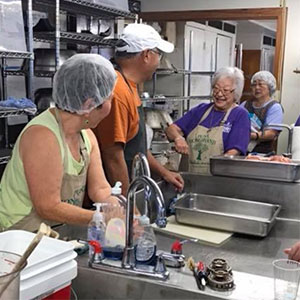
The temple is supported by members’ dues and fundraising activities, helped by friends and the community. Monetary, material, and non-material donations are always welcome. Donations are tax deductible. Volunteer opportunities include yard maintance for the temple grounds, repair and maintence of the temple, and the toban system. Toban means “on duty.” A volunteer work group is referred to as a toban, loosely organized by districts but you may join another group if you prefer. Each toban works 3 months in a year and is assigned to clean up or prepare refreshments once a week for a month.
Conclusion
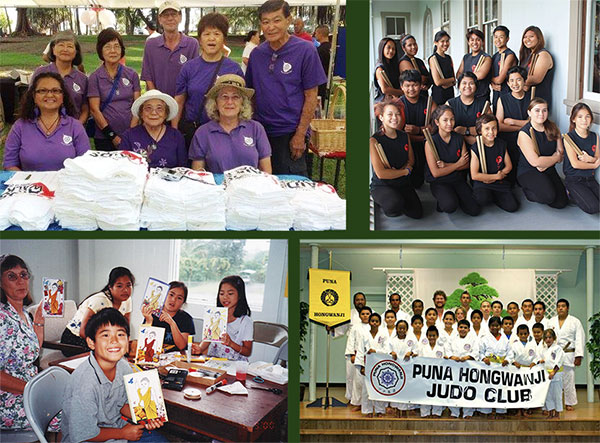
Puna Hongwanji is a Buddhist community located on a beautiful Hawaiian island, with the primary purpose to educate and spread the teachings of Shin Buddhism. The community welcomes and embraces all people beyond all differences of race, gender, religious background, sexual orientations, and culture. If you are looking to join an accepting Buddhist community in Hawaii, Puna Hongwanji is the place to go.
References
“The Essentials of Jodo Shinshu.” Jodo Shinshu Hongwanji, https://www.hongwanji.or.jp/english/teaching/index.html.
“Jodo Shinshu.” The Buddhist Society, https://www.thebuddhistsociety.org/page/jodo-shinshu/.
Puna Hongwanji Brochure https://punahongwanji.org/wpcontent/uploads/sites/7/2018/01/puna_brochure.pdf
“Shinran Shonin.” The Pluralism Project, https://pluralism.org/shinran-shonin
Web, Puna. “Home.” Puna Hongwanji Mission, https://punahongwanji.org/.